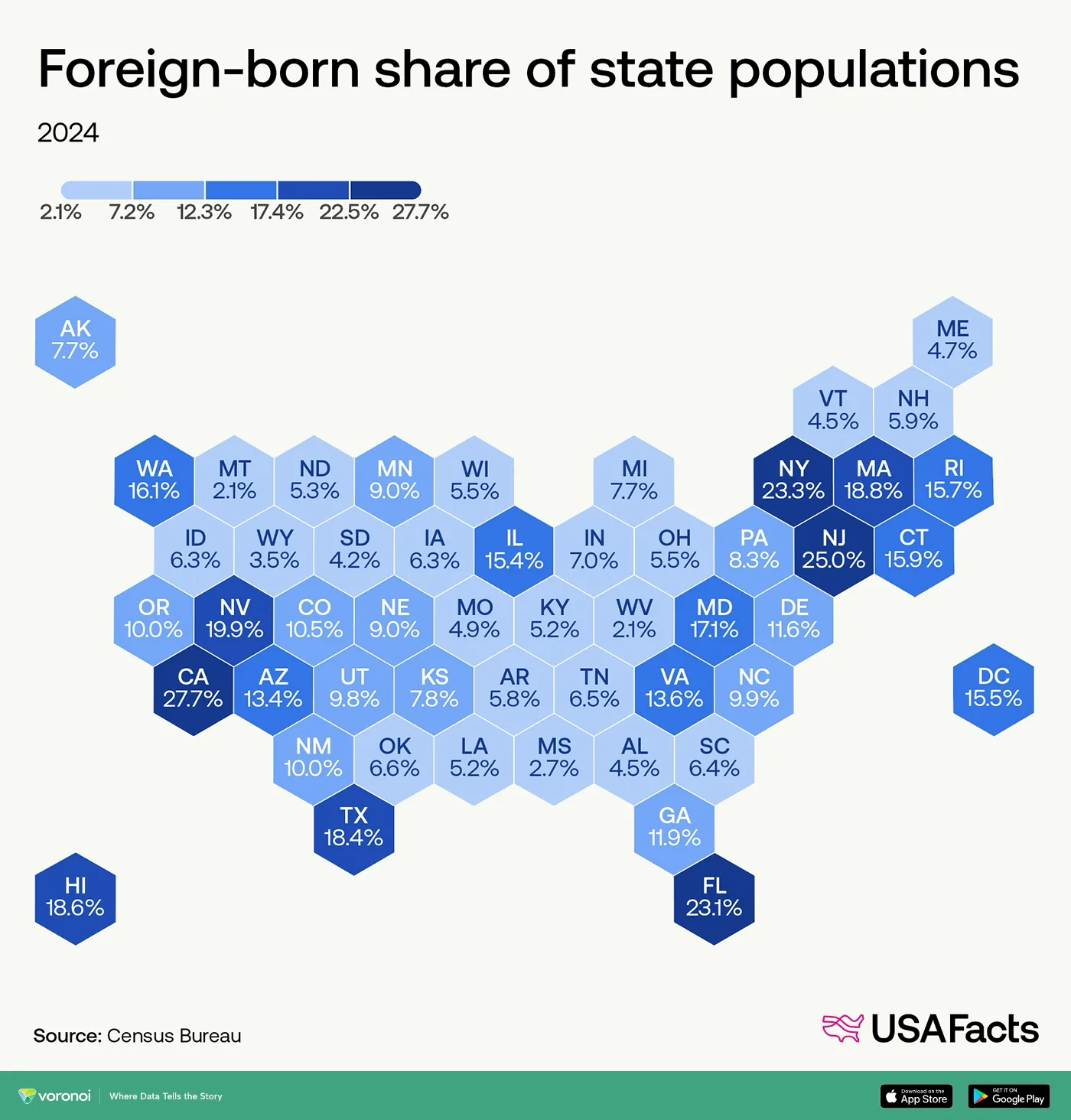![]()
See this visualization first on the Voronoi app.

Mapped: What Share of Each State’s Population is Foreign Born?
This was originally posted on our Voronoi app. Download the app for free on iOS or Android and discover incredible data-driven charts from a variety of trusted sources.
- California has the highest share of foreign-born residents at 27.7%—more than 1 in 4 people.
- Montana, West Virginia, and Mississippi have the smallest shares, each under 3%.
- The U.S. foreign-born population is at a historic high, with origins shifting towards Asia and Latin America.
The U.S. has long been shaped by waves of immigration, and today, those numbers are reaching historic highs. Using the latest 2024 data from the U.S. Census Bureau, USAFacts visualizes the foreign-born share of each state’s population. California leads, but patterns vary widely depending on region and history.
Here’s the full dataset showing the share of each state’s population that is foreign-born:
| Rank | State Name | Foreign-born Share (%) |
|---|---|---|
| 1 | California | 27.7 |
| 2 | New Jersey | 25.0 |
| 3 | New York | 23.3 |
| 4 | Florida | 23.1 |
| 5 | Nevada | 19.9 |
| 6 | Massachusetts | 18.8 |
| 7 | Hawaii | 18.6 |
| 8 | Texas | 18.4 |
| 9 | Maryland | 17.1 |
| 10 | Washington | 16.1 |
| 11 | Connecticut | 15.9 |
| 12 | Rhode Island | 15.7 |
| 13 | District of Columbia | 15.5 |
| 14 | Illinois | 15.4 |
| 15 | Virginia | 13.6 |
| 16 | Arizona | 13.4 |
| 17 | Georgia | 11.9 |
| 18 | Delaware | 11.6 |
| 19 | Colorado | 10.5 |
| 20 | New Mexico | 10.0 |
| 21 | Oregon | 10.0 |
| 22 | North Carolina | 9.9 |
| 23 | Utah | 9.8 |
| 24 | Minnesota | 9.0 |
| 25 | Nebraska | 9.0 |
| 26 | Pennsylvania | 8.3 |
| 27 | Kansas | 7.8 |
| 28 | Alaska | 7.7 |
| 29 | Michigan | 7.7 |
| 30 | Indiana | 7.0 |
| 31 | Oklahoma | 6.6 |
| 32 | Tennessee | 6.5 |
| 33 | South Carolina | 6.4 |
| 34 | Idaho | 6.3 |
| 35 | Iowa | 6.3 |
| 36 | New Hampshire | 5.9 |
| 37 | Arkansas | 5.8 |
| 38 | Ohio | 5.5 |
| 39 | Wisconsin | 5.5 |
| 40 | North Dakota | 5.3 |
| 41 | Kentucky | 5.2 |
| 42 | Louisiana | 5.2 |
| 43 | Missouri | 4.9 |
| 44 | Maine | 4.7 |
| 45 | Alabama | 4.5 |
| 46 | Vermont | 4.5 |
| 47 | South Dakota | 4.2 |
| 48 | Wyoming | 3.5 |
| 49 | Mississippi | 2.7 |
| 50 | Montana | 2.1 |
| 51 | West Virginia | 2.1 |
Unsurprisingly, states with major urban centers and global hubs top the list.
California (27.7%), New Jersey (25.0%), and Florida (23.1%) all host large immigrant communities. On the other hand, states like West Virginia (2.1%) and Montana (2.1%) have far fewer foreign-born residents.
America’s Foreign-Born Population at a Record High
As of 2024, the share of foreign-born individuals in the United States stands at about 14.8%, marking a record high not seen since the early 20th century. Today, over 46 million immigrants live in the U.S., a number that has nearly doubled since 1990.
Regional Patterns and State-by-State Trends
While the national share is high, foreign-born populations are not distributed evenly. Coastal and larger Southern states tend to have larger immigrant populations. Texas (18.4%) and New York (23.3%) are key gateways for immigration, hosting a diverse array of foreign-born residents.
In contrast, more rural and landlocked states tend to have smaller foreign-born shares. For example, North Dakota (5.3%) and South Dakota (4.2%) have limited international migration due to fewer economic and social pull factors.
Where Are U.S. Immigrants From?
Immigrants to the U.S. come from a wider range of places than ever before. While Mexico remains the largest single country of origin, accounting for around 18 million arrivals since 1965, the composition of newcomers has shifted significantly.
In recent years, arrivals from Asia and Latin America have surged. For example, in 2022, immigrants from Asia saw the largest numerical increase in authorized arrivals, and immigration from Mexico more than doubled compared to 2006.
According to the latest rankings, after Mexico, the largest immigrant groups are from India, China and Philippines—all contributing millions of people to the U.S. population.
These changes reflect a U.S. immigration profile that is both sizable and increasingly diverse, reshaping the nation’s demographic and cultural landscape.
Learn More on the Voronoi App
Explore more global comparisons in our Voronoi post: Which OECD Countries Have the Largest Foreign-born Populations?